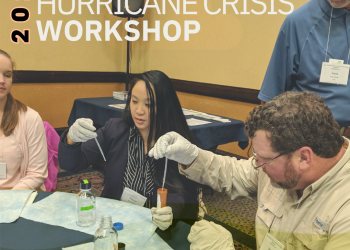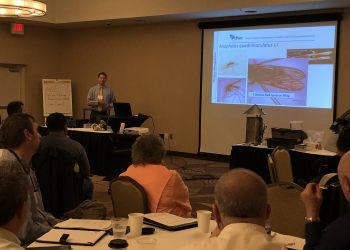By Kathryn McGrath ([email protected]), Communications Director, American Association for the Advancement of Science’s Center for Scientific Evidence in Public Issues (AAAS EPI Center).
On August 12, 2021, NACCHO and AAAS’s EPI Center hosted a webinar on PFAS Contamination in Drinking Water. Watch the recording and view the presentation slides.
An increasing number of communities across the United States are detecting per- and polyfluoroalkyl substances (PFAS) in drinking water. A class of thousands of synthetic chemicals used to make products resistant to water, heat, and stains, PFAS do not easily degrade. Exposure to trace doses of several of the most-researched compounds have been linked to harmful health effects, and recent research suggests other PFAS may also be multi-system toxicants. The U.S. Environmental Protection Agency (EPA) has not yet set Maximum Contaminant Levels (MCLs) for any PFAS but will soon begin monitoring 29 PFAS in drinking water. Many more communities may discover PFAS as monitoring expands.
Local health departments play a critical role in addressing PFAS and engaging the public. In a recent National Association of County and City Health Officials (NACCHO) webinar co-hosted with the American Association for the Advancement of Science’s Center for Scientific Evidence in Public Issues (AAAS EPI Center), researchers and local health professionals discussed the scientific evidence, local health department responses to PFAS, and how to help communities understand options for reducing or eliminating health risks posed by PFAS.
Key Takeaways
Sources of PFAS include not only manufacturing and industrial sites where PFAS may be produced or used, but landfills and incineration facilities. Wastewater treatment plant outflows can contain PFAS, as can biosolids that may be applied to fields. Another significant source of PFAS in the environment is the use of firefighting foam that contains PFAS, aqueous film forming foam (AFFF), widely used at airports, military installations, and chemical plants.
Drinking water is a major pathway for human exposure, but people can also be exposed to PFAS by eating food packaged in materials containing PFAS or grown in fields with contaminated biosolids; eating fish from contaminated waters; swallowing dust or soil; or using consumer products that contain PFAS such as non-stick cookware, stain-resistant carpeting, cosmetics, and water repellant clothing. PFAS can be difficult to treat and remove using conventional water treatment processes. Costs to install and maintain activated carbon or reverse osmosis filtration systems can be millions of dollars each year.
PFAS affect the immune, endocrine, and metabolic systems but very little is known about a majority of PFAS, including how long they linger in our bodies (referred to as half-life), their toxicity, and how different PFAS may interact in our bodies. “There is uncertainty around the science but there is also plenty of scientific evidence linking PFAS exposure to health harms,” said Dr. Tom Bruton, the scientist who leads the Green Science Policy Institute’s PFAS research and policy work.
Perfluorooctanoic acid (PFOA), one of the most well-studied PFAS, has been linked to kidney and testicular cancer, decreased antibody responses to vaccines, liver damage, increased cholesterol levels, increased risk of thyroid disease, increased risk of decreased fertility, decreases in birth weight, and increased risk of pregnancy-induced hypertension and preeclampsia. This evidence of harmful health effects led to the phasing out of PFOA and perfluorooctanesulfonic acid (PFOS) in the United States, but they are still manufactured in other parts of the world. There are concerns that replacement PFAS (such as GenX) may be just as harmful.
The EPA is preparing to set enforceable maximum contaminant levels for PFOS and PFOA and is conducting research to assess PFAS toxicity and develop laboratory methods to detect selected PFAS, among other actions.
In the absence of federal regulations, many states relied on new research to set drinking water limits well below the EPA lifetime health advisory set for PFOS and PFOA in 2016. Several states proceeded to set drinking water guidance or standards for additional PFAS not yet addressed by the EPA. Many states are addressing PFAS in water, soil, and wastewater, and limiting the use of PFAS in consumer products and the use of PFAS-containing firefighting foam.
Strategies for communicating complex PFAS-related science to the public rely on the principles of risk communication. The goal is to present accessible and clear information, establish a two-way continuous exchange with members of the public, and include communities in the decision-making process.
It can be challenging to communicate what is known and the many uncertainties related to PFAS exposure. It helps to clarify how specific uncertainties will be addressed and provide a time frame, if possible. “Empathize, even if you don’t have the answers,” offers Dr. Melissa A. Harclerode, who serves as the co-lead of the Interstate Technology Regulatory Council (ITRC) Risk Communication Toolkit. She advises that officials listen, acknowledge, and follow up on specific concerns. The ITRC Risk Communications Toolkit includes a framework for outreach strategy planning, audience assessment, and communications methods specific to PFAS as well as advice on assembling a communication team.
Sara Simmonds, the Environmental Health Division Director at the Kent County Health Department in Grand Rapids, Michigan, stresses the need to create a universal message among agencies. After PFAS was detected in northern Kent County, the Health Department was flooded with calls and developed a script on PFAS for the state’s 211 call center. The health department’s communications were developed in partnership with state agencies.
“The information was changing pretty rapidly,” Simmonds said. The county health department held daily meetings for several months with community partners, the Michigan Department of Health and Human Services (MDHHS), the Michigan Department of Environment, Great Lakes and Energy, Plainfield Township, and the company responsible for the release, in addition to monthly meetings with the EPA and the Centers for Disease Control and Prevention’s Agency for Toxic Substances and Disease Registry.
Dr. Harclerode advises that officials consider the populations most at risk and how to more equally distribute any impacts from site activities and redevelopment, especially those impacts that may be unintended.
As the Emergency Preparedness Coordinator for the Kent County Health Department, Dr. Karla Black participated in the department’s response to PFAS. She said that people were primarily concerned about their health. “They wanted to know what was in their blood,” she said. “It was really hard, because at the time, there wasn’t nearly as much data out there.” The county partnered with MDHHS on a retroactive cancer incidence study and then an exposure assessment of people who had been drinking water from private wells that contained PFAS. She said executing the study was made easier by the department’s existing emergency preparedness plans.
Simmonds said the county made sure that there was contact with the homeowner before sampling took place and the resident was called as soon as the result was received. “You need to be proactive in involving [residents] up front and keeping them informed,” Dr. Harclerode agreed. “Be vocal and transparent when you are going out to do sampling, don’t sit on results for a couple months.”
“You could hear the stress and concern about the uncertainty. We started to see as a team that we needed to have mental health resources available for residents.”
– Sara Simmonds, Environmental Health Division Director, Kent County Health Department, Grand Rapids, MI
Responding to suspected incidents of PFAS contamination challenges local health departments coordinating with multiple state and federal agencies, community stakeholders, and residents. Scientific evidence can help communities understand options for reducing or eliminating risks posed by PFAS, even as much remains unknown about these chemicals. NACCHO and the AAAS EPI Center are connecting officials with scientific experts and colleagues who can help prepare health departments to address PFAS in their communities. Contact us for more information or see Addressing Per- and Polyfluoroalkyl Substances (PFAS) in Drinking Water: Guides for Local and State Leaders.







